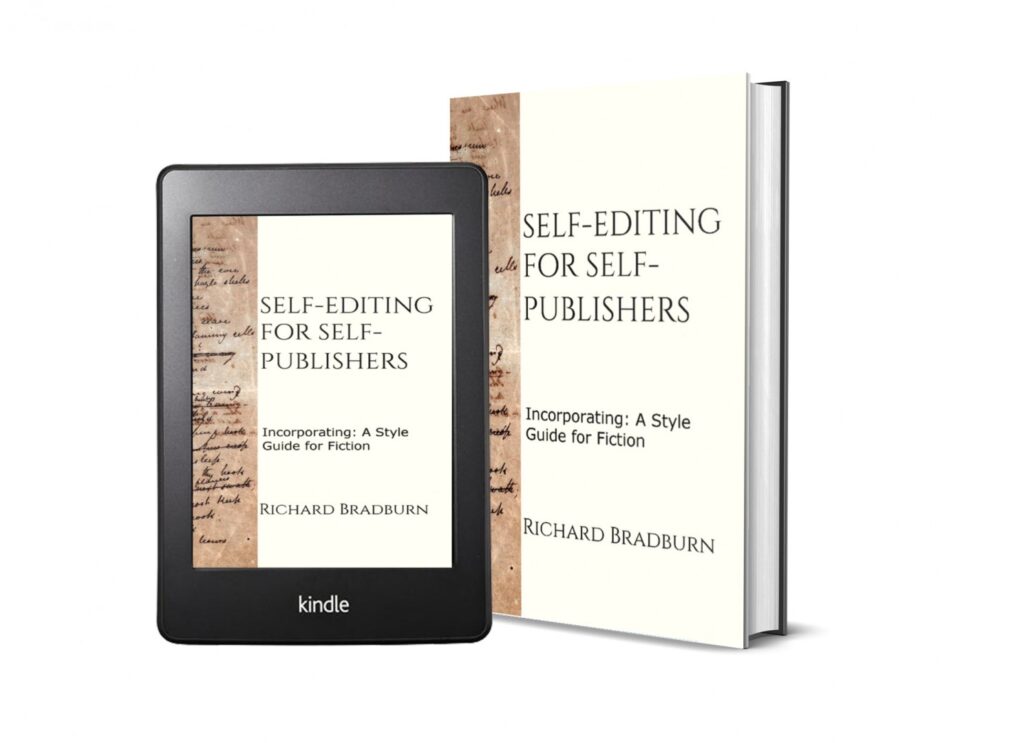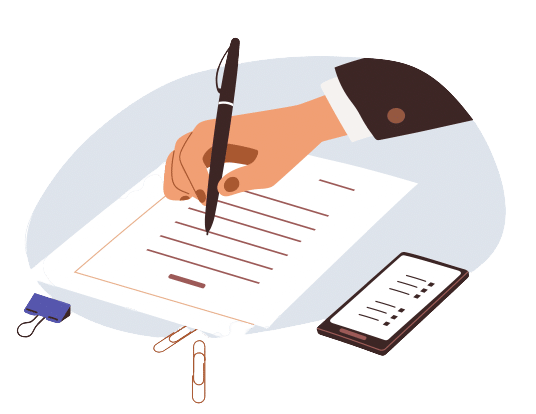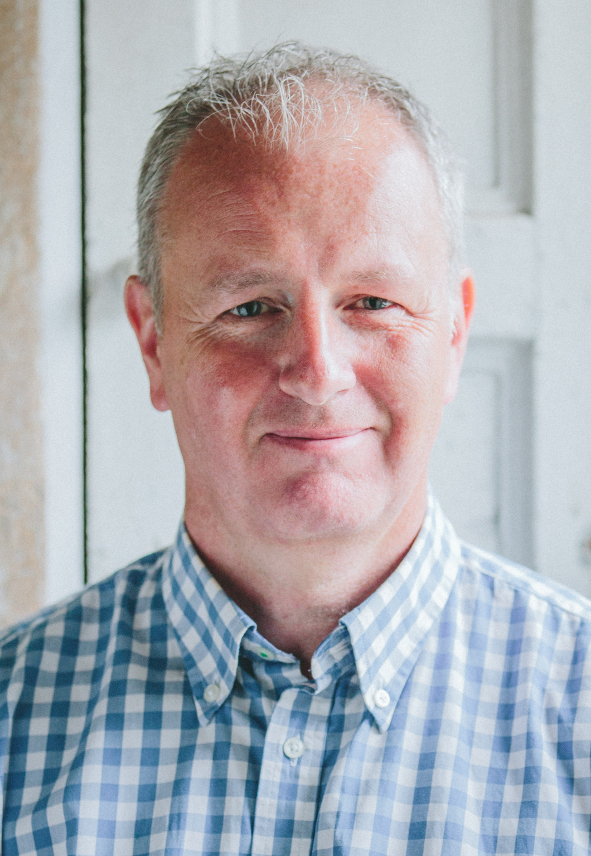If you’ve spent some time in the author space, you may have come across the term self-editing, but are not quite sure what it means.
The truth is it’s a much-overlooked part of writing that improves your book and anything you might write in the future.
So it’s pretty essential that authors learn about it.
For that reason, we decided to work alongside Richard Bradburn of Editorial.ie, and author of Self-Editing for Self-Publishers, to create a complete guide for authors on how to self-edit their own work.
Without further ado, let’s jump right into it!

Table of Contents
What is Self-Editing?
What you’re trying to do is to see your own work like a reader or, even more to the point, as an editor, agent or publisher will.
Self-editing is the process of looking at your own story as objectively as you can, seeing the flaws in it, revising and rewriting, and polishing it until it’s as good as you can make it.

“That doesn’t sound too hard—what’s the problem?”
The problem is that little word “objectively.”
You want to give yourself the ability to look at your book dispassionately and say to yourself, “Well, that scene doesn’t really work,” or “Even I’m bored with this character.”
Self-editing is the process of looking at your own story as objectively as you can, seeing the flaws in it, revising and rewriting, and polishing it until it’s as good as you can make it.
“That doesn’t sound too hard—what’s the problem?”
The problem is that little word “objectively.”
What you’re trying to do is to see your own work like a reader or, even more to the point, as an editor, agent or publisher will.
You want to give yourself the ability to look at your book dispassionately and say to yourself, “Well, that scene doesn’t really work,” or “Even I’m bored with this character.”
Getting that objective distance from your own writing is a really difficult art to master, but without it, you’ll never be able to see the flaws in your stories.
“But hang on, that’s what editors are for, isn’t it?”
Yes, that’s true.
Editors are not involved in the writing of your book, so can look at it completely objectively.
They can see flaws that you can’t, no matter how many times you read it, and even if you self-edit your own work really well, they will still see things that you missed.
But if you rely on editors to do all your editing, your editing costs are going to be high, and you will keep making the same mistakes in your own writing.
As we covered in our article on book publishing costs, they can get pretty high, so we want to do anything we can to get it down.

Introducing:
Booklinker Collections
One landing page for all your books. 100% free.
One link for easy sharing of your books across your backmatter, websites, emails, and social media.
How to Self Edit
Now that you understand why you’d want to self-edit, before sending your book off to an editor, it’s time to start self-editing.
The first question you probably have is:
Can I save time and do it as I write?
This is not recommended, as self-editing is best done after you’ve finished the first complete draft of your book.
If you try and mix creativity (writing new scenes) and editing previous scenes, there’s a great danger that you’ll fall into the “two steps forward and one back” trap, where you never seem to be getting anywhere with your book and eventually might even succumb to writer’s block.
Once you’ve finished your book, the best thing you can do is try and forget about it for six months.
“What?!”
We get it, that seems crazy. You’re not forgetting about it completely. What you’re trying to do is to get objective distance.
If the book is fresh in your mind, you will be full of the writing of it, borne along on the current of your own creativity.
For the next step of self-editing, you need to be an editor, remember, that an editor hasn’t seen your book before.
You might think that you can’t possibly forget your book, having put all that effort into it, and while it’s true that you won’t forget it completely, you’d be surprised how different it seems to you if you are able to put it aside for even just a couple of months.
Some scenes that you thought were really gripping will feel a bit flat. One character that you only put in as an afterthought might seem a lot more memorable on second reading. You’re beginning to see your book as others will.
“But I can’t wait months. I want to write another ten books this year!”
Well, there’s nothing stopping you from writing another few books while you’re waiting on this one.
In fact, that’s often the best way to get some distance on your last book – write another. You’ll be so wrapped up creatively in the new material that you’ll speed up the process of getting some distance on the last book no end.
Tips for Perspective Changes
What you’re trying to do is to make your surroundings different from your normal writing process.
Below are some ways you can help change the perspective you have of your writing:
- Change the font of the manuscript.
- Edit it on a different computer
- Change the orientation from portrait to landscape.
- If possible, perhaps edit in a different room than your writing room.
- Listening to your book using text-to-voice software, for a really different perspective.
Richard recommends a structured way of self-editing, mirroring the process that a book goes through at a traditional publisher.
They break down the work on a draft manuscript into structural (or developmental) editing and copy-editing.
This is a great way to go about it, as it’s very difficult to get a clear perspective on which scenes are working, and which characters are pulling their narrative weight, if you’re also, at the same time, checking that you’ve punctuated all your dialogue correctly.
Professional editors don’t do both of these tasks at the same time, for exactly this reason.
Structural Editing
In this first structural stage of self-editing, you’re looking at:
Plot problems: Continuity, plausibility, too much plot, or too little)
Pacing: Are there “flat” bits?
Characters: Main character arcs properly defined, two-dimensional characters, minor characters taking up too much time and space)
Technical writing: Issues like point-of-view, head-hopping, management of tense, filtering and description, and balance of dialogue, action, and exposition.
Does your book fit the expectations of the genre you’re writing in?
Self-editing gets easier the more often you do it. Professional editors can cover all these issues at the same time.
If you’re completely new to self-editing, it might be best to break it down into separate “missions”, first looking at the plot, then the characters, and so on.
Copy Editing (AKA Line Editing)
Next is the copy-editing (sometimes called line-editing) stage, where the focus is on the sentence level. The “shape” of your book, the characters, the scenes, and the plot, is pretty much final. Now you’re polishing the prose.
Punctuation, especially around dialogue, is often a problem.
Common questions relating to punctuation and copy editing are:
- Double quotes or single?
- Does the comma go inside or outside the quotes?
- What happens when someone interrupts someone else?
- What’s the proper sentence structure
- Are you using adverbs and adjectives correctly?
- Are you using capitalization correctly?
- Use of language
- How to write numbers
- How do you write telepathic communication?
- What’s maid-and-butler dialogue?
Self-Editing Resources
Next, Richard supplied some self-editing resources to help.
The original book on self-editing was “Self-Editing for Fiction Writers” by Ronnie Browne and Dave King, which was the first book to treat self-editing as a separate discipline, worth studying in its own right.
It’s still a great read, but is a bit long in the tooth now, predating the explosion of self-publishing by nearly a decade.
Richard felt there was room for an updated and more structured guide, so he wrote “Self-editing for Self-publishers” which goes through each step of the self-editing process outlined above, with copious examples, before-and-after edits, and a host of other useful resources like how to write a proper synopsis, which you’ll need if you’re ever going to submit to agents or publishers.
Why Self-Edit Over Hiring an Editor
Ok, so now you see that self-editing is a lot of work, and are probably thinking, why bother doing it yourself over a professional editor?
While you can do that, you’re ultimately paying that editor for their time, and if they’re spending time going through the manuscript fixing all your punctuation, or trying to keep track of the fifty main characters you’ve written into the book, then your editing fees are going to be large.
If you’ve corrected most of the “mechanical” errors yourself, they’ll have less to do, and what time they spend will be adding really good critique to your book, spotting things that you may have missed, improving the plot and characters even further, getting your book into really top shape to give it the best chance with agents of publishers, or the marketplace.
Additionally, by fixing a lot of your own writing issues, the chances are that you won’t make those kinds of mistakes again, saving writing time and editing fees on new stories.
Self-Editing Checklist
Make sure you finish your book first.
You don’t want to be trying to edit it as you go along.
However scrappy you might think your first draft, it’s more important to get to the end than try and fix things as you go along.
Below is a checklist to follow for self-editing your own book:
1. Put your draft away when you’ve finished it. Give yourself some time apart from the book.
2. When you’re ready to start self-editing, use a few formatting tricks to make it look and feel different to you. Change the font, the line spacing, and the orientation (portrait to landscape/magnification). If you can, work in a different room, or on a different computer. Try audio.
3. If it’s your first-time self-editing, a good manual on the subject by your elbow will keep you focused.
4. On your first pass through the manuscript, concentrate on big-picture issues, like whether the plot is convincing, the characters fully realized and empathetic, the pacing balanced, with a genre-appropriate mix of action and dialogue, and exposition.
5. In the second stage of self-editing, go through looking at the detailed level, punctuation, spelling, sentence structure, language choices, adverb, and adjective use, capitalization etc.
Conclusion
“One last question. If I’ve done all this, do I need to bother with an editor at all? Can’t I just publish the book as it is?”
Good question!
The truth is that you’ve brought the book to the point where it’s the best you can make it on your own. That might be fine for some authors, but it’s not the best that your book can be. For that, you will still need to have an editor look at it.
You will be surprised, even after all your hard work, how much you’ve missed, or could improve upon.
But their fees will be much lower than if you hadn’t bothered, you will be a much better writer, and you will have a book that you can truly stand by and be proud of.

Introducing:
Booklinker Collections
One landing page for all your books. 100% free.
One link for easy sharing of your books across your backmatter, websites, emails, and social media.
Author
-
Richard Bradburn is Managing Editor of editorial.ie, a literary consultancy based in south west Ireland with a global client list spanning four continents. He works primarily with fiction authors, helping them to realise their dreams of producing a top-quality book. Clients have gone on to self-publish best-sellers, secure agent representation, be traditionally published and be shortlisted for prestigious literary awards. He also works with a number of prestigious financial companies, government agencies and traditional publishing houses on various projects from marketing materials right through to book-length work. He has been published in The Irish Times, Arts and Letters Daily, and wrote his own guide to self-editing, Self-editing for Self-publishers. He talks regularly at writer’s conferences in the UK and Ireland on writing and editing.



